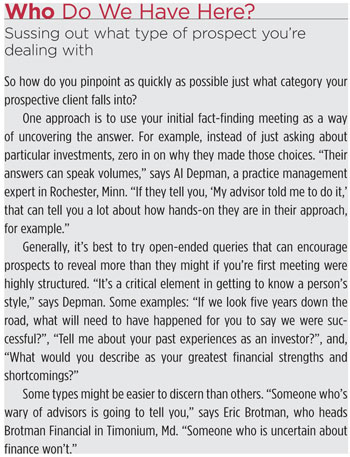Not long ago Kelly Campbell was working with a prospect. This prospect was an engineer who, as you might expect, was a highly analytical type. He’d come to their meeting with all of his investments and holdings laid out neatly and precisely on a spreadsheet. Everything was there, from his Social Security benefits to the expenses he paid. “We looked for any holes in it, but there weren’t any,” says Campbell, whose Alexandria, Va-based Campbell Wealth Management has $300 million in assets.
But what the prospect couldn’t do with his spreadsheet was adjust it according to different scenarios. So Campbell sat down with him at a computer and showed him what would happen to his income and assets, depending on a variety of variables. “He really liked that,” says Campbell. Soon after, the man decided to sign on and became a client.
Prospects are people and, as a result, have an infinite variety of financial needs and interests. But as Campbell can tell you, for an advisor’s purposes, they tend to fall into a few predictable categories— those who have had bad experiences with previous advisors, those who are just plain indecisive or, like the engineer, those who are highly analytical, to name just three. And, for best success, each type of prospect requires a special, customized kind of hand-holding. “Understanding the prospective client’s mindset should change the way you go about pursuing that person,” says John Nersesian, managing director of wealth management services at Nuveen Investments in Chicago. In other words, you wouldn’t zero in on the same issues with, say, a worrier as you would with an aggressively macho risk-taker.
It’s an especially important matter these days. Fact is, wooing prospects and turning them into paying clients requires particular finesse in these volatile and confusing times. “I find that most advisors feel client acquisition is the most challenging thing they face in today’s environment,” says David Patchen, managing director for practice management at Raymond James Financial Services in St. Petersburg, Fla.
With that in mind, here’s a look at five common client types and the best approach to take with each, along with strategies for pinpointing quickly just what kind of prospect you’re targeting (see sidebar page 59).
The Analytical Type
They’re often engineers, people who need thorough, detailed information and, generally, want to be hands-on investors. They keep often startlingly comprehensive records of
their portfolios.
Your move:
These people need to see all the numbers in their financial plan. That includes rates of return, yearly projections for every year of retirement—any data used to produce your recommendations. “You want to show them more than they need,” says Campbell.
In some cases, that may mean emphasizing different points from those you usually focus on. Take Eric Brotman, head of Brotman Financial, a Timonium, Md., firm with $90 million in assets. His team, he says, has a particular facility for helping to aggregate and organize clients’ investments. Ultimately, this saves them a lot of time. With analytical types however, “we’ll talk more about outcomes, how we’re going to keep them on track in terms of projections,” says Brotman, who emphasizes that prospective clients generally come to him via referrals and don’t need a lot of persuading to sign on.
If you don’t come through with a detailed analysis that’s up to snuff—and, therefore, can’t create a sufficiently positive impression—all is not lost, however. You just have to act fast. Take Campbell. His process includes a fact-finding meeting and a second session when they go over the financial plan his team has created based on information gathered in the first get together. But, several years ago, he worked with a prospective client, an engineer, who was dissatisfied after the first meeting. So Campbell asked him what else he needed. The answer was that he wanted more information. The result: Campbell scheduled an extra meeting, during which he gave the prospect access to the firm’s software, allowing him to plug in different numbers and create a variety of scenarios. “He was able to go in and move some numbers around,” says Campbell. He ended up becoming a client.
The ‘You-Take-Care-of-It’ Type
The opposite of the analytical individual, this type wants you to handle everything. He or she doesn’t want to be bothered with the details.
Your move:
Chances are, this prospect not only doesn’t want to be bothered with too much information, but could be turned off by it. In that case, if you produce a financial plan, says Campbell, “Be sure only to provide the highlights,”—say, five pages, with each one covering the most important points related to retirement, college funding or other issues of concern.
At the same time, since you’ll be expected to make certain decisions without explaining them to the client, the prospect will need to have a higher-than-usual level of trust before hiring you. “They need to feel you’re really going to be there for them,” says Campbell.
The ‘My-Previous-Advisor-Was-a-Disappointment’ Type
This one is pretty common these days. That may be because prospects’ portfolios took a  hit. But it’s more likely the result of a previous advisor’s failure to communicate adequately. “It’s rarely about returns,” says Brotman. Or, it could be due to more egregious behavior. In any case, the result is the same—there are many prospects out there whose first inclination is to not trust you or any other advisor they encounter.
hit. But it’s more likely the result of a previous advisor’s failure to communicate adequately. “It’s rarely about returns,” says Brotman. Or, it could be due to more egregious behavior. In any case, the result is the same—there are many prospects out there whose first inclination is to not trust you or any other advisor they encounter.
Your move:
The good part about working with these prospects is that they’ll most likely let you know pretty quickly on their own about their negative experience and why they didn’t like their previous advisor. The bad part: You’re dealing with someone whose first reaction is to be mistrustful, if not downright suspicious.
Your primary mission is to establish yourself as a person of integrity, with the client’s best interest at the top of your mind. Emphasize that your immediate objective is to get know each other. “Make it clear that you want to work together, as long as the person feels comfortable working with you,” says David Adams, an advisor with Southwestern Investment Group of Raymond James Financial, a Nashville firm with $150 million in assets. And explain that you’re interested in a long-term relationship—and you’re willing to take it slow.
Then, pay attention to the specifics of the prospects’ complaints. If, for example, they were unhappy with a previous advisor’s communication habits, it’s important to underscore your own process. Take Brotman. He emphasizes his teamwork—if one advisor isn’t available, there will be another staff member who can help. On the other hand, he points to prospective clients who felt they didn’t have one advisor able to provide a full picture of their situation. “They had one for their 401(k), one for cash management, and so on,” he says. “There were so many moving pieces that it was overwhelming.” So, he talked about his specialty--how his team would aggregate and consolidate their investments to become a “clearinghouse” of sorts.
Another approach is to use what Nersesian calls a “rules of engagement checklist” that includes client and advisor expectations for the relationship. If the prospect was disappointed with a previous advisor because, say, there was poor communication, you can tailor the checklist to include points that relate specifically to that problem. (“The advisor promises to respond to a question within 24 hours”, for example, or, “The advisor will be in touch at least once a month, with two in-person meetings a year.”).
The Procrastinator Type
They just can’t pull the trigger, although they seem to be genuinely interested in your practice.
Your move:
Adams finds that the main reason prospects procrastinate is because they don’t understand the financial planning process. “No one has ever walked them through it,” he says. To that end, he pulls out a “process flow chart,” a visual, step-by-step representation of how his system works. (For example, meet two weeks after the first session; two weeks after that the prospect should make a decision; 90 days later conduct their first review). “They see that all they have to do is show up. Someone else is going to show them what to do,” he says. “They get peace of mind.”
Your key move is combating vagueness on the part of the prospect. That means being direct. Try to find out what’s making them procrastinate—what they’re leery of. Also, if the person insists on needing more time, ask how you can speed things up. Or if the individual wants to run the matter by an accountant, “Ask what information they need that would be helpful in moving the conversation along,” says Al Depman, a practice management expert in Rochester, Minn. And be sure to set a specific date for your next discussion.
Another approach is to give the person a reason why it’s important to make a decision sooner rather than later. “You need to provide a catalyst,” says Nersesian. Examples: Your recommendations are based on certain market conditions that you want to take advantage of quickly.
Ultimately, with procrastinators, it’s best not to let the issue fester for too long. Adams, for example, used to allow procrastinators to drag their feet for months. Now, when that happens, he tends to figure nothing is going to come of it and simply waits for them to contact him. “If the matter goes beyond 60 days, you might have to fish or cut bait,” says Depman. “You need to make a decision about whether the end result is worth it.”
The Disorganized Type
These individuals are, well, not particularly organized. Their documents are a mess. They can’t remember when they made various investments. Their record keeping is a disaster. Brotman, for example, remembers one prospective client who came to the first meeting with two suitcases. “She placed them on our conference table and said, this is everything I have,” he says.
Your move:
One tack is to approach the initial fact-finding meeting differently from the way you would handle it for other prospects. Brotman, for example, treats it like “a blank sheet”, something more akin to an interview where his team asks pointed questions that help prospects figure out what information they need to provide and where they might find it.
Adams finds his flow chart also helps with these folks. He points to a woman who came in with her accounts in complete disarray. So, he showed her the system, emphasizing that his team would help her through it and take the burden off her shoulders, and exactly how long the process would take. “She’d thought it would be two years, so she was happy,” he says. She became a client, bringing in over $1.5 million in assets. Certainly worth putting up with some disorganization for that, wouldn’t you say?


